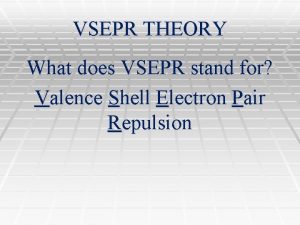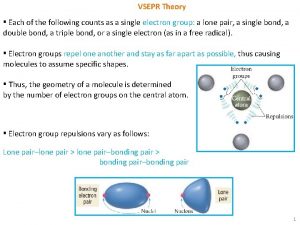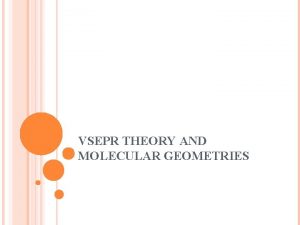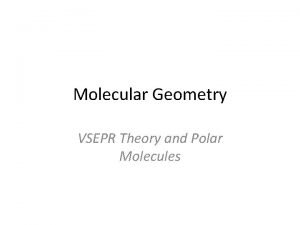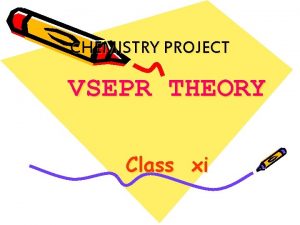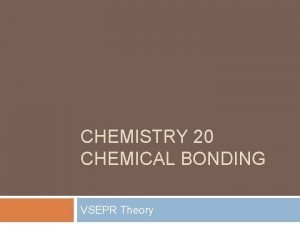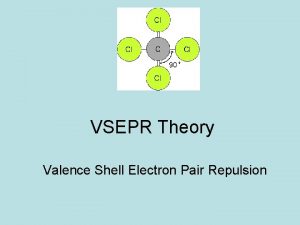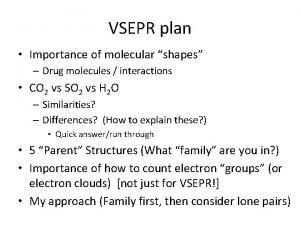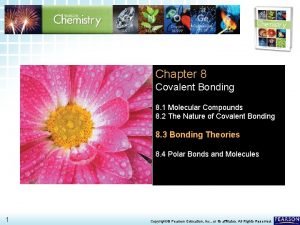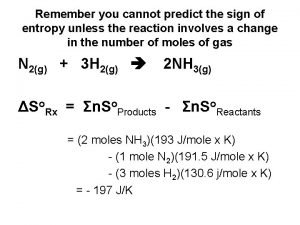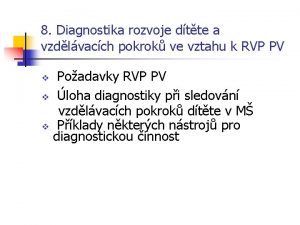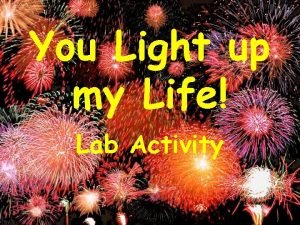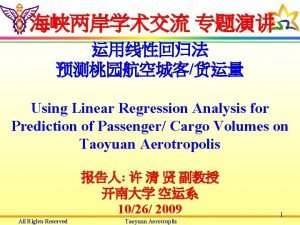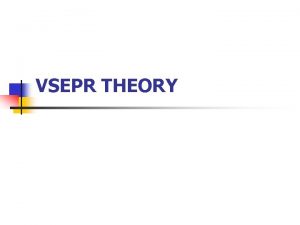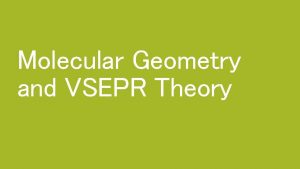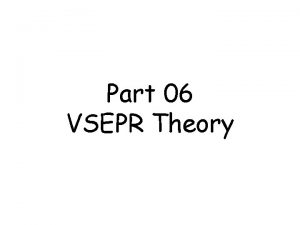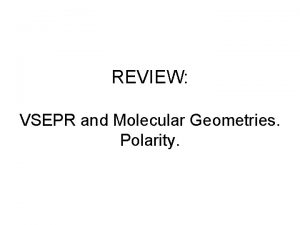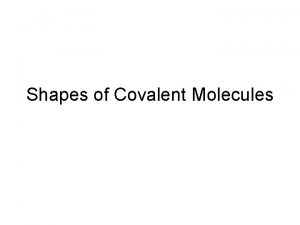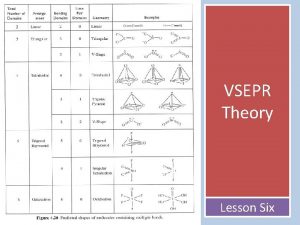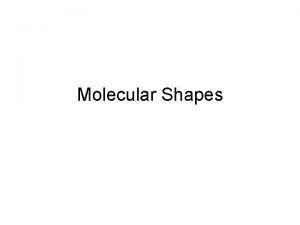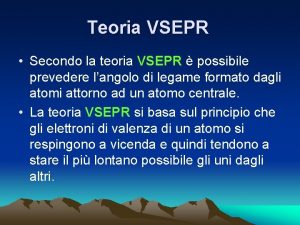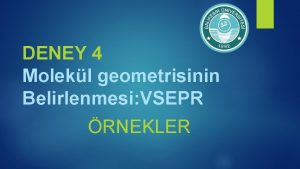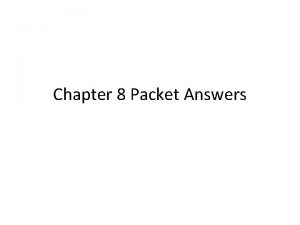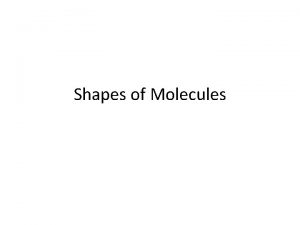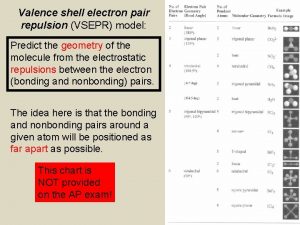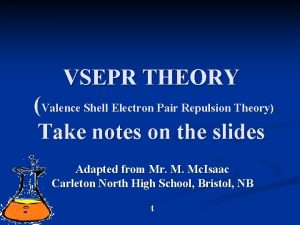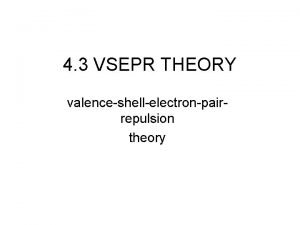VSEPR Theory Pg 91 97 Understand predict VSEPR






















- Slides: 22

VSEPR Theory Pg 91 -97 Understand predict VSEPR shapes for molecules

Molecular Shapes Stereochemistry - the study of the 3 -D spatial configuration of molecules and how this affects their reactions A theory was developed to predict the shape of molecules → VSEPR Theory (Valence-Shell-Electron-Pair-Repulsion Theory) Based on the electrical repulsion of bonded and unbonded electron pairs in a molecule (negative repels negative) Solid = in plane of page Dashed = behind (away) Wedge = ahead (toward)

VSEPR Theory Rules & Guidelines The number of electrons pairs can be counted by adding the number of bonded atoms plus the number of lone pairs 3 -D distribution about the central atom is predicted by arranging all pairs of electrons as far apart as possible The type, number and direction of bonds around the central atom of a molecule determine the shape of the resulting molecule. Lone pairs and bonded electrons are treated equally

Using VSEPR Theory to Predict Molecular Shape There are six possible shapes according to VSEPR and we will be looking at the following compounds to analyze these Be. H 2(s), CH 2 Og), CH 4(g), NH 3(g), H 2 O(l), HF(g) The first step is to draw Lewis formulas of the molecules and then consider the arrangement of all pairs of valence electrons **All pairs of valence electrons repel each other and try to get as far from each other as possible**

Shape 1 - Linear → Be. H 2 Lewis Formula Be Bond Pairs 2 Lone Total General Pairs Formula 0 2 AX 2 Electron Pair Arrangement Stereochemical Formula linear X–A–X linear • This Lewis formula indicates that Be. H 2(s) has two bonds and no lone pairs on the central atom. *Exception* Beryllium does not follow OCTET RULE • VSEPR theory suggests that the two bond pairs will be farthest apart by moving to opposite sides to a bond angle of 180° • This gives the molecule a linear orientation

Practice Draw the Lewis Formula for CO 2: Draw the VSEPR structure:

Shape 2 - Trigonal Planar → CH 2 O Lewis Formula Bond Pairs 3 Lone Total General Pairs Formula 0 3 Electron Pair Arrangement AX 3 trigonal planar • This Lewis formula indicates that BH 3(g) has three bonds and no lone pairs on the central atom. • VSEPR theory suggests that the three bond pairs will be farthest apart by moving to a bond angle of 120° to each other. • This gives the molecule a trigonal planar orientation. Stereochemical Formula

Practice Draw the Lewis Formula for BBr 3 → what do you need to remember about B? : Draw the VSEPR structure:

Shape 3 - Tetrahedral →CH 4 Lewis Formula Bond Pairs 4 Lone Total General Pairs Formula 0 4 AX 4 Electron Pair Arrangement tetrahedral • This Lewis formula indicates that CH 4(g) has four bonds and no lone pairs on the central atom. • VSEPR theory suggests that the four bond pairs will be farthest apart by arranging in three dimensions so that every bond makes an angle of 109. 5° with each other. • This gives the molecule a tetrahedral orientation. Stereochemical Formula

Practice Draw the Lewis Formula for Si. H 4: Draw the VSEPR structure:

Shape 4 - Trigonal Pyramidal → NH 3 Lewis Formula Bond Pairs 3 Lone Total General Pairs Formula 1 4 AX 3 E Electron Pair Arrangement Stereochemical Formula tetrahedral • This Lewis formula indicates that NH 3(g) has three bonds and one lone pair on the central atom. • VSEPR theory suggests that the four groups of e-’s should repel each other to form a tetrahedral shape (bond angle = 109. 5°) • But the lone pair is very repulsive, thus pushes the atoms more to a 107. 3° bond angle • This gives the molecule a trigonal pyramidal orientation. Trigonal pyramidal

Practice Draw the Lewis Formula for PCl 3: Draw the VSEPR structure:

Shape 5 - Angular → H 2 O Lewis Formula Bond Pairs 2 Lone Total General Pairs Formula 2 4 AX 2 E 2 Electron Pair Arrangement tetrahedral • This Lewis formula indicates that H 2 O(l) has two bonds and two lone pairs on the central atom. • VSEPR theory suggests that the four groups of e-’s should repel each other to form a tetrahedral shape (bond angle = 109. 5°) • But the TWO lone pairs are very repulsive, thus pushes the atoms more to a 105° bond angle • This gives the molecule an bent (V shape) orientation. Stereochemical Formula Angular (Bent)

Practice Draw the Lewis Formula for OCl 2: Draw the VSEPR structure:

Shape 6 - Linear (Tetrahedral) →HF Lewis Formula F Bond Pairs 1 Lone Total General Pairs Formula 3 4 AXE 3 Electron Pair Arrangement Stereochemical Formula Linear (Tetrahedral) • This Lewis formula indicates that HF(l) has one bond and Three lone pairs on the central atom. • VSEPR theory suggests that the four groups of e-’s should repel each other to form a tetrahedral shape (bond angle = 109. 5°) • But since there are only two atoms with one covalent bond holding them together, by definition, the shape is linear, as is the shape of every other diatomic molecule.

Practice Draw the Lewis Formula for HCl: Draw the VSEPR structure:

Summary of VSEPR Theory describes, explains, and predicts the geometry of molecules. It does this by counting all the pairs of electrons that repel each other to minimize repulsion → the pairs will stay as far away from each other as they can Steps to determine shape of molecule STEP 1: Draw the Lewis Formula for the molecule, including the electron pairs around the central atom STEP 2: Count the total number of bonding pairs and lone pairs of electrons around the central atom STEP 3: Refer to Table 7 (page 95), and use the number of pairs of electron to predict the shape of the molecule


Multiple Bonds Multiple bonds (double and triple bonds) are ONE bond are treated as such when predicting the VSEPR shape of a molecule EXAMPLE: Predict the shape of C 2 H 4(g) Draw the Lewis Formula H H Count the pairs of electrons around the central carbon atoms The carbon has 3 bonds (2 single, 1 double) and no lone pairs This is the same as a trigonal planar configuration EXAMPLE: Predict the shape for C 2 H 2(g)

Practice

Homework Page 96. # 1 -3 1. Explain how the words that the VSEPR acronym represents communicate the main ideas of this theory 2. Use VSEPR theory to predict the geometry of a molecule of each of the following substances. Draw a stereochemical formula for each molecule, and state whether the central atom obeys the octet rule: a. Cl 2 O(g) b. H 2 S(g) e. Si. Br 4(l) d. PF 3(g) e. BBr 3(l) f. HCl(g) 3. Use VSEPR theory to predict the shape of each of the following polyatomic ions: a. PO 43 - b. Br. O 3 - c. NH 4+ Page 98, #6 -7 6. In order to make the rules of VSEPR theory work, how must a multiple (double or triple) bond to be treated? 7. Use Lewis formulas and VSEPR theory to predict the shapes around each of central atom of the following molecules: a. CO 2(g) b. HCN(g) c. CH 2 CHCH 3 d. CHCCH 3 e. H 2 CO(g) f. CO(g)

Page 104, #1 -3 1. Use Lewis formulas and VSEPR theory to predict the molecular shape of the following molecules. Include a stereochemical formula for each molecule. a. H 2 S(g), hydrogen sulfide b. BBr 3(l), boron tribromide c. PCl 3(l), phosphorous trichloride d. Si. Br 4(l). Sulfur tetrabromide e. Be. I 2(s), beryllium iodide 2. Use Lewis formulas and VSEPR theory to predict the molecular shape around the central atom(s) of each of the following molecules. Provide stereochemical formulas. a. CS 2(l), carbon disulfide b. HCOOH(g), formic acid c. N 2 H 4, hydrazine d. H 2 O 2(l), hydrogen peroxide e. CH 3 CCCH 3(l), 2 -butyne 3. Draw the Lewis formula and describe the shape of each of the following ions: a. IO 4 b. SO 3 c. Cl. O 2 - 2 - -
 What does vsepr theory predict
What does vsepr theory predict Vsepr stand for
Vsepr stand for To understand recursion you must understand recursion
To understand recursion you must understand recursion Vsepr theory molecular shapes
Vsepr theory molecular shapes Vsepr metoda
Vsepr metoda Vsepr formulas
Vsepr formulas Electron pair geometry
Electron pair geometry Vsepr theory class 11 chemistry
Vsepr theory class 11 chemistry Vsepr theory assignment
Vsepr theory assignment Vsepr theory
Vsepr theory Electron domain geometry of acetic acid
Electron domain geometry of acetic acid Trigonal pyramidal with lone pair
Trigonal pyramidal with lone pair Importance of molecular geometry
Importance of molecular geometry Bond 8 generacji
Bond 8 generacji Predict the sign of the entropy change
Predict the sign of the entropy change Reading vipers explain
Reading vipers explain Explain vipers
Explain vipers Zkratka nnn
Zkratka nnn You light up my life answer key
You light up my life answer key Predictogram
Predictogram Variabel sekunder
Variabel sekunder Predict cyber crime
Predict cyber crime Linear regression predict
Linear regression predict

